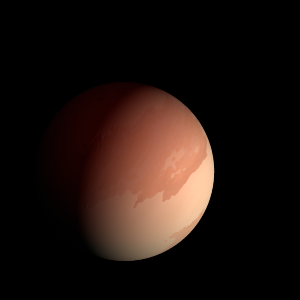|
|
Space Astro
|
Info for exoplanet "Exemado-n"
| Scientific (actual) data |
|---|
| Name | Kepler-1136 b |
| Planet status | Confirmed |
| Radius | 0.146 |
| Orbital period | 2.36172 |
| Discovered | 2016 |
| Updated | 2021-02-05 |
| Tconj | 2454970 |
| Publication | Announced on a website |
| Detection type | Primary Transit |
| Alternate names | 2MASS J18562587+4414449 b, K02193.01, KIC 8282651 b, KOI-2193 b, KOI-2193.01, WISE J185625.84+441445.3 b |
| Star name | Kepler-1136 |
| Right ascension | 284.11° |
| Declination | 44.25° |
| Mag j | 13.869 |
| Mag h | 13.225 |
| Mag k | 13.174 |
| Star distance | 545 |
| Star metallicity | 0.03 |
| Star mass | 0.72 |
| Star radius | 0.68 |
| Star age | 3.24 |
| Star temperature | 4512 |
| Star alternate names | 2MASS J18562587+4414449, KIC 8282651, KOI-2193, WISE J185625.84+441445.3 |
| Wikipedia article | Kepler-1136 b |
Back
| |
| Fictional info (?) |
|---|
| Suggested name | Exemado-n |
| Planet type | Cold planet |
| When viewed from Earth, this proximity to Kepler-1136 means the planet can only be seen near the western or eastern horizon during the early evening or early morning.
.
The two polar ice caps appear to be made largely of frozen gas.
A prominent result is the "great gray spot", a giant storm that is known to have existed for centuries since it was first detected by scanner.
Its north and south poles, therefore, lie where most other planets have their equators. Wind speeds can reach 90 metres per second.
One of this planet's nice moons is mostly crowded with odd medieval humanoids, the "Yroquz-i", that survive in the forest while seeking the somewhat smaller "Bekirew'era" during the day. They are related to Gehe-saqu-re but with scales and vary in length from 28 to 48 cm. They can endure temperatures from -80 to -40°C and even ultra violet light. |
| Estimated population | 90000000000 |
| Atmosphere | Carbon dioxide | 72% |
| Water | 24% |
| Oxygen | 4.3% |
| Methane | 0.015% |
| Atmospheric pressure | 0.0012 bar |
 |
| Moon | Sulen | Huge slightly egg-shaped rocky moon |
| Google search for Exemado-n |
|
Website by Joachim Michaelis
|
|
|
|